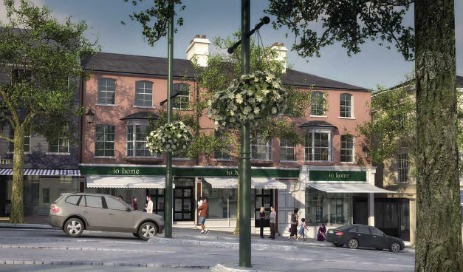 The U.K.’s greenest, cutest town. Image: Red Tree (2004) LLPCharles, the prince of Wales, is building the U.K.’s greenest town. We know what you’re thinking, because we’ve seen Hot Fuzz too: It’s important to be suspicious of British villages that look too good to be true. But Sherford, a planned eco-town that was just approved for construction in southwestern England, has a lot going for it. It won’t be finished until 2020, so we don’t know yet if it’ll be secretly full of armed grannies, but on paper at least it’s pretty cool.
The U.K.’s greenest, cutest town. Image: Red Tree (2004) LLPCharles, the prince of Wales, is building the U.K.’s greenest town. We know what you’re thinking, because we’ve seen Hot Fuzz too: It’s important to be suspicious of British villages that look too good to be true. But Sherford, a planned eco-town that was just approved for construction in southwestern England, has a lot going for it. It won’t be finished until 2020, so we don’t know yet if it’ll be secretly full of armed grannies, but on paper at least it’s pretty cool.
The activist formerly known as Prince: You’d figure the British Royal Family’s idea of going green would be having the servants stuff only 11 endangered capons for supper instead of 12. But Charles is a pretty hardcore environmentalist, with a nonprofit (the Prince’s Foundation for the Built Environment) and a super-earnest documentary.
Sherford homes: The plan of the city is based on “the qualities and features of successful, traditional West Country towns.” In other words, it should fit in aesthetically with its older neighbors: no weird modern buildings, obvious gadgetry, or New Deal-style boxes. The concept drawings of the central area look a lot like the High Street in any other English town.
 A rendering of a future Sherford street.Red Tree (2004) LLPSherford’s founding principles include walkability (dense residential neighborhoods, easy access to town and neighborhood centers), social inclusiveness, and recreation (there are several sports complexes). But it will also include technological innovations: wind power, solar power, green roofs.
A rendering of a future Sherford street.Red Tree (2004) LLPSherford’s founding principles include walkability (dense residential neighborhoods, easy access to town and neighborhood centers), social inclusiveness, and recreation (there are several sports complexes). But it will also include technological innovations: wind power, solar power, green roofs.
The Prince’s Foundation for the Built Environment and the developer Red Tree intend half of all Sherford’s energy to come from renewable sources on site, mostly from 390 feet turbines looming over the town’s 400 acre park, and local biomass heating and power systems that run on renewable fuels.
It is hoped that two-thirds of the bulky construction materials will be sourced from within a 50-mile radius and that CO2 emissions from the homes and businesses will be 60 percent lower than demanded by building regulations. Work buildings employing an estimated 7,000 people will have roofs planted with greenery or covered with a thin layer of rubble to encourage insects and birds. Three-quarters of buildings will be fitted with solar power systems and an organic farm for local food production is planned in the park.
Basically: It’s cute, it’s smart, and it has a British accent. It is the David Tennant of towns.
Keep calm and agrarian: Plans for Sherford include a large park (about 2/3 the size of Central Park) and a network of open spaces for wildlife and walkers to move through.
Like any new construction, though, the town will have an impact on the countryside:
Building Sherford will involve removing more than a mile of hedgerow, and the loss of wildlife habitats. The developers claim they will increase the number of native trees and that farmland birds such as the linnet will be relocated to the park. The wind turbines will also affect the setting of an iron age hill fort, and housing could be built over two possible bronze age burial mounds.
Some locals aren’t psyched about that, but they’ve decided to ride with it. Sherford is very persuasive. The David Tennant of towns, people! Wouldn’t you do its bidding?
When first proposed residents in the neighboring village of Brixton lodged 3,000 objections. Opposition was dropped after villagers were involved in the design process.
“This is beautiful countryside with a stream running through it and it’s a damn shame,” said Derek Curtis, a parish councilor.
“But we have decided to make the best of it. We have all been to see Poundbury and architecturally it was much better than what local councils and housebuilders have done in the past.”



